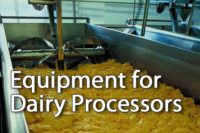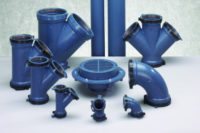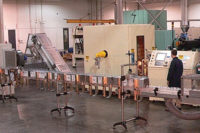Small milk processing operations might think that on-site blowing molding equipment is only for high-volume dairies. But that’s not so. At the International Dairy Show in Chicago in November, the French company Serac showed a combination blow-molder, filler and capper for mid-sized dairy processing operations. The company said its new Combox H2F machine is specifically designed for dairy bottle production below 12,000 bottles per hour, what it calls “medium-sized production rates.”
The blow-molded dairy bottle is celebrating a milestone anniversary in 2013: 50 years. Uniloy North America says it originated the lightweight, handled plastic milk jug in 1963. A half-century later, the blow-molding equipment supplier is teaching best practices in its 15,000-square-foot learning center at its headquarters in Tecumseh, Mich.
The center includes a state-of-the-art analytical lab and fully equipped classrooms, as well as hands-on space featuring two Uniloy intermittent extrusion reciprocating screw machines, and a B&W continuous extrusion shuttle machine. Uniloy conducts classes for new and veteran machine operators.
For the dairy industry, Uniloy is focused on creating more sustainable packaging solutions and manufacturing processes, as well as other innovations. Some specific initiatives include:
- Testing calcium carbonate and/or bio-resin bottle development to enable container re-designs, light-weighting and other ways to reduce consumption of petroleum-based materials.
- Running six-layer extended-shelf-life milk bottles on the lab’s B&W shuttle system to explore new shelf-stable packaging options.
- Testing improved methodologies for reducing machine system energy usage.
- Identifying and pursuing lightweight projects and opportunities.
While some processors blow mold bottles on-site and convey them to a filler, others are purchasing equipment that integrates the blowing, filling, labeling and capping functions into one line.
The German equipment maker Krones AG offers such a machine. The company’s new Contiform 3 series is a small-cavity machine with the capability of blowing 81,000 containers an hour, at a maximize size of 0.75 liters. The high-speed stretch blow-molding machine is fitted with a newly developed blow-molding station that operates entirely without lubrication, according to the company.
The goal of every equipment maker is to provide processors with low-maintenance, simple-to-operate machines. Krones’ wet-end monobloc ErgoBloc L integrates the technology of the Contiform 3 small-cavity stretch blow-molding machine with the company’s Contiroll labeling technology and fillers from the new Modulfill series. The individual machines have been networked using an intelligent control system. According to Krones, the total operating costs are up to 10% lower than for conventional bottling lines. In addition, the monobloc’s footprint is 30% smaller.
Versatility and cost effectiveness
Blow-molded PET bottles are versatile. Serac calls this type of bottle “the preferred packaging” for fresh milk, flavored milk, drinking yogurt, probiotics and other high-value dairy products. The company said PET can be blow-molded into a wide variety of shapes and sizes, giving it an advantage over other types of containers. Resealable PET bottles help fluid milk manufacturers seize on the grab-and-go trend, Serac said.
One reason dairy processors invest in on-site blow-molding units is to eliminate the cost of transporting and storing bottles. This is a growing concern for quality and food safety, Serac states. The company says that it is more efficient to transport the small bottle preforms (which are blown on-site into bottles) compared to blown bottles. One risk of shipping fully formed bottles is that they can be scratched or distorted in transit, Serac said.





